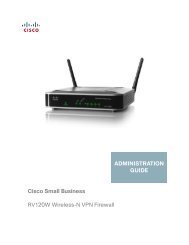Cisco Catalyst 6500 Supervisor 2T Architecture - Ipland
Cisco Catalyst 6500 Supervisor 2T Architecture - Ipland
Cisco Catalyst 6500 Supervisor 2T Architecture - Ipland
Create successful ePaper yourself
Turn your PDF publications into a flip-book with our unique Google optimized e-Paper software.
White PaperThe RPF processing block responsible for the RPF check is also responsible for a number of other processingchecks as well. These additional processing checks include the following:● IP Multicast forwarding requires an RPF check, to build its distribution tree. PIM uses the RPF information todetermine which interface to send Join and Prune messages, for a given IP source● To support MPLS aggregate VPN support, a lookup using the MPLS label can be performed to determine theMPLS VPN id associated with it● For IPv4 and IPv6 packets, a source MAC to IP binding check can be performed● For IPv4 and IPv6 packets, source AS mapping check can be performed which facilitates a later lookup in theACL TCAM● For IPv4 and IPv6 packets, a source group tag (SGT) lookup can be performed● VPN and QoS mapping for MPLS packets is supportedClassification Processing and the Classification Memory (ACLs)Two TCAM banks providing a total of up to 256 K access control entries are available for classification ACLs. Bydefault, the PFC4 reserves 16 K entries for QoS ACEs and 48 K entries for Security entries. The PFC4XL reserves64 K entries for QoS ACEs and 192 K entries for Security ACEs. The first ACL TCAM bank is used for standard QoSand Security ACL entries, and the second TCAM bank is used for Security and CTS (RBACL) entries, which requirelabel-based functions. This combined TCAM design can be used to store Security ACLs, QoS ACLs, RBACLs, oraccounting results.The Layer 3 forwarding engine provides for a dual lookup into each bank, allowing for four lookups to be performedsimultaneously. This means that for each input packet, up to four classification rules can be matched during IFE(ingress) processing, and up to four classification rules can be matched during OFE (egress) processing.Each classification TCAM entry is 144 bits wide, and uses a lookup key to initiate a lookup into the TCAM. Thislookup key uses input fields such as the ACL label (which is obtained from the LIF table), packet type (IPv4, IPv6,and more) and other fields to generate the key. The result of the TCAM lookup provides a pointer into theclassification SRAM that holds the actual ACE entry.The Layer 3 forwarding engine works in conjunction with the Layer 2 forwarding engine, which holds and maintainsthe hit counters for each access control entry. Every time a classification ACL is matched during IFE or OFEprocessing, the ACL counters in the Layer 2 forwarding engine are updated to reflect the hit.The classification TCAMs have the following capabilities:● Ingress DSCP mutation, using one of 14 ingress DSCP mutation maps selected by ingress LIF map tablelookup● Address compression on IPv6 addresses, prior to lookup into the TCAM● Security ACLs (ingress/egress classification) returns a permit/deny for the packet, based on configured ACLpolicies● ACL redirects (ingress/egress classification), which define which packets are to be redirected (thismechanism can be used for features such as policy-based routing through input classification)● RPF+ (ingress classification only), which provides the ability to ignore RPF result for certain classified flows● RBACL support. The generation of SGT and DGT based on IP classification. Also, classification of flowsbased on SGT (input and output classification) or DGT (only output classification) of the packet is enabledthrough these TCAMs.● Ability to generate ACL-based VPNs (ingress classification only), useful for implementing VRF select ornewer routing mechanisms like MTR (multi-topology routing)© 2011-2012 <strong>Cisco</strong> and/or its affiliates. All rights reserved. This document is <strong>Cisco</strong> Partner Confidential Information. Page 36 of 46
















